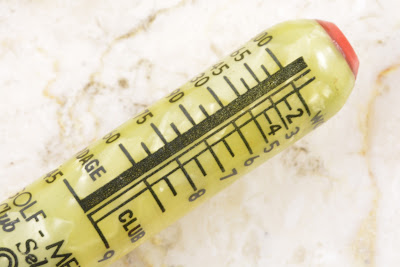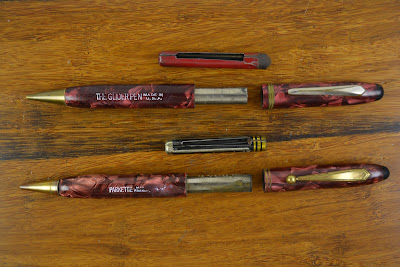This article has been edited and included in The Leadhead's Pencil Blog Volume 5; copies are available print on demand through Amazon here, and I offer an ebook version in pdf format at the Legendary Lead Company here.
If you don't want the book but you enjoy this article, please consider supporting the Blog project here.
Like golf. Even though I don’t play the game.
A couple things come to mind when someone uses the term “golf pencil.” It refers generally to any short, stubby pencil that might fit conveniently in a pair of shorts while strolling around the green – short enough to be a lady’s pencil, but fat enough to pass for a masculine accessory (at least masculine enough to keep a golfer from being harassed without mercy by the others in the foursome). It also refers to those short wooden pencils golf courses give away with your scorecards as you set out for the day.
Here’s a third sort:
The two shorter examples came my way in a larger lot of pencils - I can’t remember which one. They are marked “Golf-Meter / Club Selector / Golf Meter Co.”
At the top, opposite the clip, is a chart that suggests a club depending on how far from the hole a duffer should find himself:
The C within a circle suggests a copyright, and the name “Golf Meter Co.” looked like a promising lead, which panned out. The Golf-Meter Co. of Kalamazoo, Michigan, began copyrighting their brochures and advertising materials in 1944. Here’s an entry from the 1946 copyright register:
And, a cross-reference: to William T. Rietzke, dba Golf-Meter Company:
The Golf-Meter pencil must have enjoyed some measure of commercial success. The earliest advertising I found for it was in the July, 1946 edition of Popular Mechanics:
Newspaper advertisements in late 1946 show our pencil exactly. One which appeard in the November 26, 1946 Battle Creek (Michigan) Enquirer, directed customers to send orders to the P.&D. Supply Company, on East Michigan Avenue at Monument in Battle Creek:
Meanwhile, an advertisement in the December 8, 1946 St. Louis Post-Dispatch referred customers to the Famous-Barr Co. of St. Louis:
The pencils were still being advertised in 1954; here’s an ad from the Chicago Tribune on June 6, 1954:
Rietzke filed one last round of advertising materials for copyright protection, in 1955. I haven’t found an end date for when the Golf-Meter pencil was discontinued, but production may have been continued by the manufacturer after Rietzke called it quits. Did you notice the salesman’s sample language on the larger example in that first picture?
Under the golf meter on the back side is an imprint which confirms what the appearance of all three pencils suggests:
They were made by Ritepoint.


















































